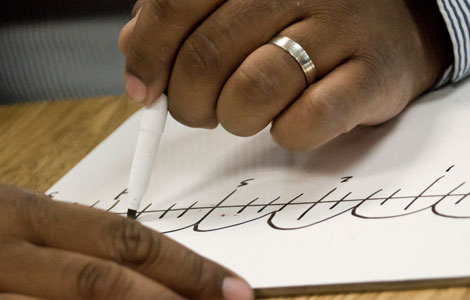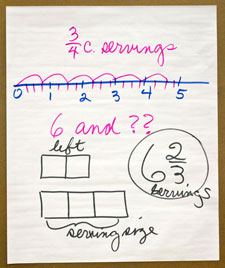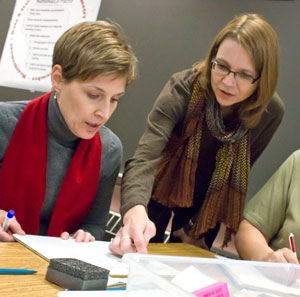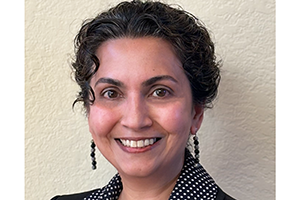
How many ¾-cup servings of popcorn can you get out of 5 cups of popcorn, and what’s going to be left over for midnight snacking?
That was one of the real-life fraction word problems a group of local teachers took on at a recent workshop. Their goal was not just to figure out the answer to the problem, but to experiment with new and better ways to teach mathematics to their students.
UWM’s School of Education developed and is leading the Common Core Leadership in Mathematics (CCLM) project, designed to help local schools make the transition to new academic standards for mathematics education that have now been adopted in 45 states, the District of Columbia and two U.S. Territories.
The common core standards grew out of a push by the National Governor’s Association and the Council of Chief State School Officers to assure consistency in mathematics education from state to state while improving teaching and learning.
Cutting-edge work

“This is really cutting-edge work,” says DeAnn Huinker, professor of education, one of the UWM faculty members involved in the local CCLM partnership. Other partners include the public school systems in Milwaukee, Wauwatosa, Mequon-Thiensville and South Milwaukee.
Wisconsin adopted the common standards in mathematics and English/language arts in June 2010, and districts are moving toward incorporating them into their curricula. A new state assessment system is being created to test students’ knowledge/mastery of the Common Core State Standards (CCSS) topics and themes. Statewide implementation is expected by 2015, according to the state Department of Public Instruction (DPI).
“These standards are aligned with college and career expectations, will ensure academic consistency throughout the state and across other states that adopt them, and have been benchmarked against international standards from high-performing countries,” said Tony Evers, state superintendent of public instruction, in announcing Wisconsin’s adoption of the standards.
“The new common core standards are designed to help students gain a deep, fundamental understanding of mathematics,” says Huinker, “but they will also allow for valid comparisons across states.” The new standards will also focus on how mathematics works in everyday life, says Huinker. “This approach really respects the discipline of mathematics and what we know about how students learn.”
“The professional development process is going to be very intense,” says Henry Kepner, UWM professor emeritus of mathematics education and former president of the National Council of Teachers of Mathematics. “Teachers don’t really know how different the things they’ll be teaching kids are going to be.”
Replacing memorization with visual tools

While some areas of study won’t change as much, says Huinker, the approach to teaching concepts like fractions will change significantly. Currently, for example, teachers might have approached the popcorn problem by discussing how to divide fractions by inverting the denominator. And students might have simply memorized the formula.
The new standards encourage the use of visual tools like number lines, bar charts and tape diagrams –drawings that look like a segment of tape, which are used to illustrate number relationships. These tools are widely used in high-performing schools in Asia and Europe .
The common standards concept borrows ideas on teaching from states and countries whose students do well in mathematics, says Huinker. “The U.S. is criticized as having a fragmented, incoherent curriculum that’s a mile wide and an inch deep.”
The 40 educators currently involved in the common core standards professional development program earn five credits at UWM with tuition waived. The program is funded by the U.S. Department of Education through the UW System’s Teacher Quality Initiative.
The group met for two weeks in the summer, and will continue to meet twice a month throughout the school year to study the new standards and discuss ways to teach them. They are also bringing the ideas back to other mathematics teachers in their districts and are helping with district-wide planning.
The start of something new
Those involved like being in on the start of something new.
“The whole nation is going this way,” says Sarah Koneazny, a mathematics teacher-leader for MPS. “I figured I would be in at the beginning.” Greg Coleman, a fifth grade mathematics teacher at Stuart Elementary in Milwaukee, said he’s enjoying the opportunity to learn about the new common concepts early in the process. “I like that we’re having a chance to crack them open and see what we’re going to be rolling out.”
They’re also passionate about the need to improve mathematics education.
“I’ve been feeling a real sense of urgency that the U.S. as a whole and our school district and my classes need to ratchet up our expectations,” says Mary Lock, who teaches eighth grade in Mequon-Thiensville. “Our students need to be competitive in the global economy and that means we need to adjust the way we teach, because we’re falling behind other developed nations.”
UWM faculty and staff involved in the project include Huinker; Kepner; Kevin McLeod, associate professor of mathematics; and instructors Connie Laughlin and Janis Freckmann. Project advisers from the districts are Sharonda Harris, MPS; Paige Richards, South Milwaukee; Sue Chmielinski, Wauwatosa; and Melissa Hedges, Mequon-Thiensville.






